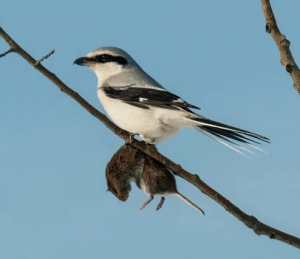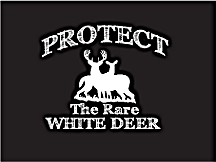
Is White Coat Color a Disadvantage?
January 31, 2024
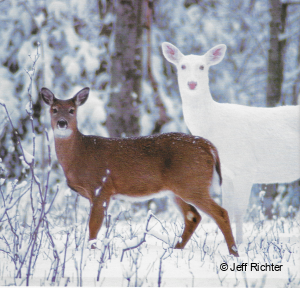
White Deer are supposed to stand out to predators, but what about in
winter? Photo by Jeff Richter, from White Deer: Ghosts of the Forest.
The white coat question
Open about any article on white deer and you read something like: “White deer are more likely to be preyed upon because they can’t easily hide from predators.” Or “White deer are much more apt to be killed by predators.” It is the gospel of white deer belief. But is it true?
The assumption that white color is a disadvantage for deer “because they can’t hide” or “they will be killed by predators” has two problems. The first is something called snow. The second is “what predators?”
A backdrop of snow
Wisconsin has cold and snowy winters—especially in the north where snow cover can last five months or longer. According to weather.gov:
“Average seasonal snowfall totals range from 40 to 50 inches across much of central and northeast Wisconsin, to 100 to 125 inches across the snowbelt region of Vilas County.”
Snow is part of winter in most northern states, and a white coat is actually the perfect winter camouflage (ask any polar bear, Arctic fox, or snowshoe hare).
Under these circumstances, a counterargument could be made that brown deer are more easily seen by predators because they stand out so much.
What about during the rest of the year?
As far as a summer background, no doubt about it, white deer stand out like a sore thumb….to humans anyway. Whether that makes them more vulnerable to predators may not be the case.
Jeff Richter and John Bates discuss this very topic in their book: White Deer: Ghosts of the Forest, a collection of observations, info, and photos of white deer taken in the Boulder Junction area of Vilas County (yup, the place that gets 100-125 inches of snow a year).
The book cites several studies on how color affects predation.
One study involved releasing owls and shrikes (a small hunting bird) in an enclosure with both brown and white mice. The study had mixed results: The owls tended to take more white mice, but the shrikes (at least in open areas) took more brown mice.
“The researchers concluded that visually-oriented predators use a specific hunting search image, because when the voles (meadow mice) were equally visible, the shrikes took the brown voles. The odd coloring of the albinos actually helped protect them in the open from visual hunters like shrikes. Thus, the color of the prey appears to make little difference as long as the prey generally looks and acts like a known prey item.”
Mammals, too, may rely more on a combination of shape and movement for prey recognition. In other words, if the prey generally looks and acts like food, no matter what its color, it’s a candidate for dinner.
Now, about all those predators
A common assumption is that large predators are waiting like lions on the African plains ready to attack any deer in sight.
The truth of the matter is that the largest predators of deer, mountain lions and wolves, have both been extirpated (regionally killed off) from most of the country. So the issue of whether color affects predation, at least on adult deer and at least in most areas, is moot—there simply aren’t many animals around anymore large enough to kill a grown deer.
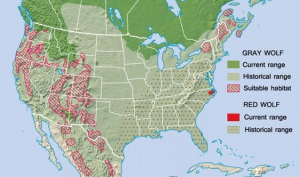
Gray wolf occurrence in the U.S. The green is current range; the gray is historical
range. Map from Defenders of Wildlife
Mountain lions only occasionally end up in Wisconsin and wolf numbers are low (only about 1000 statewide as of 2023–almost all in the northern part of the state). Although efficient pack hunters, wolves don’t really want to risk injury or work any harder than they have to and usually target sick, weak, or snow-hindered deer (any color will do).
“Biologists have long recognized that the crust that typically forms on the snow in northern Minnesota in late March or April is a particularly difficult time for deer. Their pointed hooves will break through most crusts, which impedes their ability to travel for food. It also leaves them exceptionally vulnerable to predators, like wolves, which are more frequently able to travel on the crust.” (From Timberjay News, Tower, Minnesota)
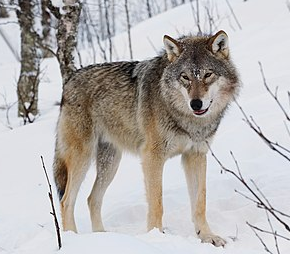 Interestingly, wolves actually have poor color and distance vision. Even though they have excellent night vision and a keen ability to detect movement, they are quite near-sighted and can’t see very well past seventy-five feet.
Interestingly, wolves actually have poor color and distance vision. Even though they have excellent night vision and a keen ability to detect movement, they are quite near-sighted and can’t see very well past seventy-five feet.
Coyotes occasionally take adult deer, but again, the “weakness” factor, opportunism, and snow undoubtedly play a role in this kind of predation.
What about fawns? Does color affect their survival?
While adult deer aren’t usually plagued with predation, this is not the case with fawns. Predators–coyotes in particular, but also bears and bobcats–take huge numbers of fawns. Can coat color make a difference here?
Amy Sprecher, who lives close to a group of white deer near Leland, Wisconsin, has watched them closely for many years. She observed two sets of twin fawns in 2020–each set with one white and one brown fawn. One white fawn survived from one set; one brown fawn survived from the other set.
Unfortunately it may be getting harder for fawns of any color to survive in the Leland area. Amy remembers keeping track of seven white does in 2013. They all had twins (14 fawns total)–half were white and half were brown. All the fawns survived.
In 2018, however, out of six fawns of different colors that were born that spring, only one survived—and it was white.
Does background color make a difference in summer?
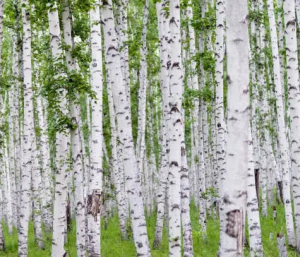 Jeff Richter makes an interesting observation in his book “White Deer: Ghosts of the Forest.” It turns out snow and deer aren’t the only things in the Northwoods that can be white…
Jeff Richter makes an interesting observation in his book “White Deer: Ghosts of the Forest.” It turns out snow and deer aren’t the only things in the Northwoods that can be white…
“The first albino fawn I ever observed was bedded down among fallen white birch trees. Was it just coincidence that it was there or was it a conscious attempt by the doe to keep its offspring inconspicuous from predators? Is it possible that albino survival rate is increased simply when they frequent areas with white birch in significant amounts?”
There are just no studies on this subject and white fawns are far too rare to even make a study possible, so the answer remains in the realm of speculation.
The most dangerous predator of all
While white color may not be a significant factor with animal predators, it does make a difference to human hunters–the biggest “predators” most deer will ever have. In fact, hunting is by far the biggest killer of adult deer of any color.
A 2014 study conducted by the Wisconsin DNR and UW–Madison found that hunting caused four times the mortality of any other cause of death, and in northern Wisconsin hunting resulted in twice as many deaths as all other mortality factors combined (starvation, wolves, coyotes, and car collisions).
Bucks in particular are targeted by hunters and have an average lifespan of only 2.9 years (compared to 15-20 years in captivity). White deer can be targeted even more:
“Because of the fascination that the albino deer create, they are more apt to be killed by hunters. Not only because they stand out more due to their white color, but because many hunters see them as a rare trophy.” (From nyantler-outdoors.com/albino-deer)
Fortunately, Wisconsin has protection for its white and albino deer, but a legal loophole (a small amount of brown makes them legal game) and the removal of in-person registration (hunter accountability) are still issues that need to be dealt with.
Many deer deaths don’t even involve predators
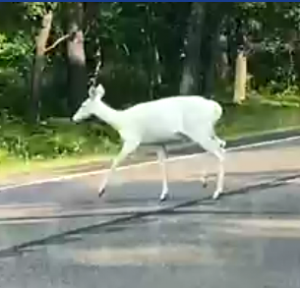 Many deer deaths have nothing to do with predators or even hunters. These include diseases (primarily CWD and EHD), starvation (it’s all that snow again), and car collisions.
Many deer deaths have nothing to do with predators or even hunters. These include diseases (primarily CWD and EHD), starvation (it’s all that snow again), and car collisions.
In fact, car kills are so common that Connecticut “harvests” almost as many deer with cars (87%) as their hunters do with guns.
In Wisconsin the ratio is lower (probably because of the state’s large number of gun kills), but Department of Transportation records, based on reported crash data, shows between 15,000 and 19,000 deer are killed annually by vehicles on Wisconsin roadways.
The Leland area has had four or five white deer killed by cars. It seems they should stand out and be easier to avoid, but most collisions happen at night or in low light. Deer just weren’t designed to avoid speeding cars or headlights.
Disease, car collisions, and starvation are all equal opportunity killers—it doesn’t matter what color the deer is.
Are white deer rejected by their herdmates?
Another common assumption about white deer is that they are ostracized by their herdmates. Nope. It doesn’t happen, or if it does, it is not the norm.
This is corroborated by several people who have spent hundreds of hours observing and photographing white deer: Jeff Richter (Mercer), Mike and Marshia Crowley (Boulder Junction), and Amy Sprecher and Mike Richard (Leland).
 Photo taken at the Seneca Army Depot. Dennis Money, Seneca White Deer, Inc.
Photo taken at the Seneca Army Depot. Dennis Money, Seneca White Deer, Inc.
John Bates, in White Deer: Ghosts of the Forest, notes: “…within a herd structure, there’s little evidence that white deer are particularly ostracized in any manner. In fact, the number of pictures of mixed herds of deer apparently mingling without incident suggest they generally get along fine.”
According to Mike and Marshia Crowley, in the herd they observed close to their home it was actually the white deer that were more often aggressive toward the brown deer.
John Bates continues…
“As for rejection by potential mates, the jury is out on white deer, but most biologists would hold that a buck in full rut, brown or albino, very likely doesn’t care one iota what color the doe is.”
Are there any advantages (besides snow) to having a white coat?
White deer have an incredible combination: striking beauty and extreme rarity. These are the two things that make them so unique and treasured. No one who has ever seen a white deer has not been awed.
Jeff Richter (again from White Deer: Ghosts of the Forest) writes:
“Even now, after hundreds of sightings over a period of many years, any time I see a white deer I feel like I am entering a modern day legend. They are so visually unusual and even unsettling that it’s hard to ever take them casually.”
On another page of his book Jeff remarks:
“Whenever I talk with people about white deer, almost without exception they recall with great clarity their first sighting. Rarely have I encountered a species that has delighted and astonished the senses of all who’ve been in the presence of these unique creatures.”
What other animal can grab your attention, create such a profound experience, and lodge such a lasting memory in your mind?
Let’s face it, all deer are beautiful animals, but a brown deer just isn’t the same.


